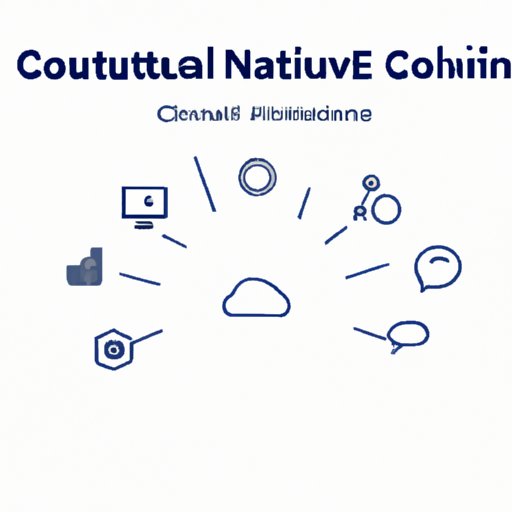Introduction to Cloud Native Technology
Cloud native technology is a new way of building and running applications that takes advantage of the cloud computing model. It enables organizations to deploy applications quickly, scale them easily and operate them reliably. This article will explore what cloud native technology is, the benefits it provides, the challenges associated with it, and how to adopt it for your organization.
Definition
Cloud native technology is a combination of technologies, tools, and practices used to develop, deploy, and manage applications in the cloud. It is designed to take full advantage of cloud computing’s scalability, reliability, and cost-effectiveness. According to the Cloud Native Computing Foundation (CNCF), cloud native technology “enables software developers and IT operations teams to build, deploy, and manage applications in the cloud without having to worry about the underlying infrastructure.”

Benefits of Cloud Native Technology
Cloud native technology has several key advantages that make it attractive to organizations looking to adopt a cloud-based approach to application development and deployment. These include:
- Faster Deployment: Cloud native technologies allow applications to be deployed faster than traditional methods because they are already preconfigured and optimized for the cloud.
- Scalability: Cloud native technologies make it easier to scale applications up or down quickly based on demand, allowing organizations to respond to changing business needs.
- Cost Savings: By taking advantage of the pay-as-you-go model of cloud computing, organizations can save money by only paying for the resources they need when they need them.
- Reliability: Cloud native technologies provide high levels of reliability and availability thanks to the use of redundant systems and automated failover.

Challenges of Cloud Native Technology
While cloud native technology offers many benefits, there are also some potential challenges that organizations should be aware of before adopting it. These include:
- Security: As with any technology, cloud native solutions require proper security measures to ensure data is kept safe and secure. Organizations must consider the security risks associated with moving their data to the cloud and take steps to mitigate those risks.
- Cost: While cloud computing can provide cost savings over traditional methods, it can also become expensive if not managed properly. Organizations must carefully evaluate their usage and costs to ensure they are getting the most out of their cloud investment.
- Scalability: Cloud native technologies can make it easier to scale applications, but organizations must be careful not to over-provision resources or they may find themselves paying for more than they need.
Adopting Cloud Native Technology
If you’re considering adopting cloud native technology for your organization, there are a few key steps you’ll need to take. These include developing a strategy for adoption, selecting the right platform, and implementing the technology.
Developing a Strategy
The first step in adopting cloud native technology is to develop a clear strategy for adoption. This should involve identifying the business objectives, determining the best cloud platform for your needs, and outlining the processes and technologies needed to achieve your goals.
Selecting the Right Platform
Once you have a strategy in place, the next step is to select the right cloud platform for your needs. There are a number of different options available, including Amazon Web Services (AWS), Microsoft Azure, Google Cloud Platform (GCP), and IBM Cloud. Each platform has its own advantages and disadvantages, so it’s important to do your research and choose the one that best fits your organization’s needs.
Implementing Cloud Native Technologies
Once you’ve selected a platform, the next step is to implement the cloud native technologies that will enable you to achieve your goals. This could involve setting up a continuous integration/continuous delivery (CI/CD) pipeline, deploying microservices, or leveraging serverless computing.
Examples of Companies Using Cloud Native Technology
Cloud native technology is being adopted by a variety of organizations across industries. Here are a few examples of companies using cloud native technology:
- Amazon Web Services (AWS): AWS is the world’s leading cloud computing platform, offering a wide range of cloud native services such as Elastic Compute Cloud (EC2), Simple Storage Service (S3), and Lambda.
- Microsoft Azure: Microsoft’s cloud computing platform offers a host of cloud native services, such as Azure Kubernetes Service (AKS), Azure Service Fabric, and Azure Functions.
- Google Cloud Platform (GCP): GCP offers a range of cloud native services, such as Google Container Engine, Google App Engine, and Google Cloud Functions.
- IBM Cloud: IBM’s cloud computing platform offers a range of cloud native services, such as IBM Cloud Foundry, IBM Watson Machine Learning, and IBM Blockchain.
Developing Cloud Native Applications
Once you’ve adopted cloud native technology, the next step is to start developing cloud native applications. This requires an understanding of cloud-native architectures, building microservices, leveraging serverless computing, and designing for scale and performance.
Understanding Cloud-native Architectures
A cloud-native architecture is a distributed system that is designed to take full advantage of the cloud computing model. It involves components such as containers, microservices, and APIs that are loosely coupled and can be scaled independently.
Building Microservices
Microservices are small, independent components that can be deployed and managed independently. They are designed to be lightweight and easy to maintain, making them ideal for cloud native applications.
Leveraging Serverless Computing
Serverless computing is a cloud computing model where applications are hosted on servers owned by the cloud provider. This allows organizations to focus on their application code rather than managing and maintaining servers.
Designing for Scale and Performance
When developing cloud native applications, it’s important to design them for scale and performance. This means ensuring that they are able to handle increased load and traffic while still performing optimally.

Future of Cloud Native Technology
Cloud native technology is continuing to evolve and improve, with new technologies and approaches being developed to make cloud computing even more powerful and efficient. Some of these include automation and orchestration, edge computing, and containers and Kubernetes.
Automation and Orchestration
Automation and orchestration are becoming increasingly popular in cloud computing, allowing organizations to automate tasks such as provisioning, configuration, and deployment. This makes it easier to manage cloud environments and deploy applications faster.
Edge Computing
Edge computing is a new approach to cloud computing that moves computation and storage closer to the edge of the network. This reduces latency, increases performance, and improves security.
Containers and Kubernetes
Containers and Kubernetes are becoming increasingly popular in cloud native technology. Containers are isolated packages of code that can be deployed quickly and easily, while Kubernetes is an open source platform for managing containerized applications.
Conclusion
Cloud native technology is becoming an increasingly popular way to develop, deploy, and manage applications in the cloud. It offers several benefits, including faster deployment, scalability, cost savings, and reliability. However, there are also some potential challenges that organizations should be aware of before adopting it. By understanding the benefits and challenges of cloud native technology, organizations can make informed decisions about whether it is the right choice for their needs.
(Note: Is this article not meeting your expectations? Do you have knowledge or insights to share? Unlock new opportunities and expand your reach by joining our authors team. Click Registration to join us and share your expertise with our readers.)
